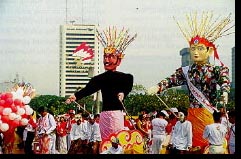 The Capital Jakarta has been called a study in contrasts: traditional and modern; rich and poor; spiritual and worldly stand side in this bustling metropolis. Among the 8 million people who call Jakarta home, one finds representatives of the many diverse ethnic and cultural groups which shape Indonesia, a reminder of the nation's motto: 'Unity in Diversity'. You may have to search high and low in this multi-cultural collage to find one of the proud ethnic Jakartans, called "Orang Betawi". Their language, Betawi Malay, has two variations, conventional Betawi Malay, spoken by elder people born and bred in Jakarta, and modern Jakarta Malay, a slang form spoken by the younger generation and migrants. The Capital Jakarta has been called a study in contrasts: traditional and modern; rich and poor; spiritual and worldly stand side in this bustling metropolis. Among the 8 million people who call Jakarta home, one finds representatives of the many diverse ethnic and cultural groups which shape Indonesia, a reminder of the nation's motto: 'Unity in Diversity'. You may have to search high and low in this multi-cultural collage to find one of the proud ethnic Jakartans, called "Orang Betawi". Their language, Betawi Malay, has two variations, conventional Betawi Malay, spoken by elder people born and bred in Jakarta, and modern Jakarta Malay, a slang form spoken by the younger generation and migrants.the younger generation and migrants. Jakarta is the port of entry for many tourist6 and busine66 people. It is home to a dynamic contrast between Western-6tyle skyscrapers, modern urban life-style6 and traditional Indonesian culture. Its rapid growth into a metropolit;an city reflects the economic, political, social and industrial development of the nation. In recent years, Jakarta has expanded its facilities for visitor6 with luxury hotels, flne restaurant6, excising nightlife end modem shopping centers. It contains many tourist attractions such as Taman Mini Indonesia Indah (Beautiful 'Indonesia in Miniature' Park), restored colonial period buildings, island resorts in the Pulau Seribu (Thousand Islands), and extensive beach recreation complex called Ancol.
The nation's capital, Jakarta, has a remarkable histcry. Its history as a trading center started as a small harbour town called Sunda Kelapa, but its actual founding dates back to the year 1527, when itwas named Jayakarta by Fatahillah of the neighbouring Sultanate of Banten. The name Japarta means City of Great Victory. During the 17th century it served as the capital of the Dutch East dies with the name Batavia. Reminders of tbis period can still be seen today in the architecture of some of the nothern parts of the city. When Indonesian independence was flnally secrued it was renamed Jakarta, and serves today as the centre of goverr meet, business and indusby, spreading over an area of more than 650 sq.km (410 sq miles).
As Indonesia's main gateway, Jakarta's Soekarno- Hatta lnternatianal Airport is the central transportation hub of Indonesia. It serves a growing number of international airlines and ie the nexus point for domestic flights acros6 the vast expanse of the archipelago. Local transport of all forms within the city is readily available. |
[Profile] [Accommodation] [Art & Culture] [Personal Data]
Design
and maintenance by
Delsy Sutirna
E-mail:
[email protected]
Last updated: January 20, 1998